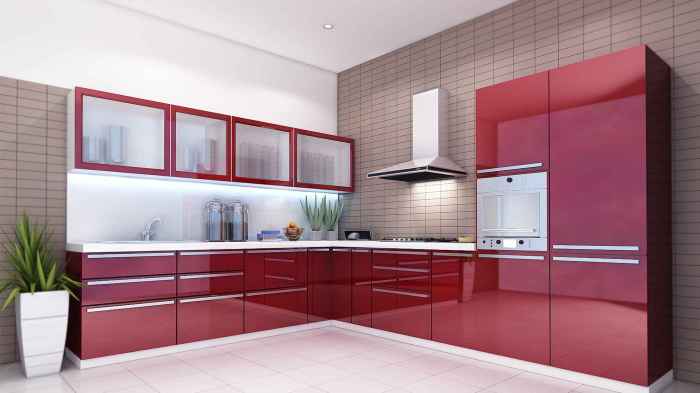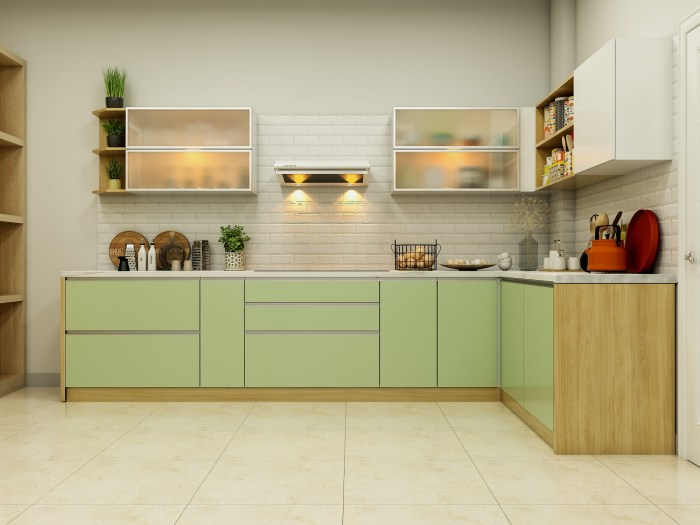Incorporating Green Design Principles in Your Modular Kitchen: A Sustainable and Stylish Choice. In this blog post, we’ll delve into the world of green design for modular kitchens, exploring its environmental and economic benefits, key principles, and practical examples. Whether you’re a homeowner looking to upgrade your kitchen or a designer seeking inspiration, this guide will empower you to create a sustainable and stylish space that meets your needs.
Green design in modular kitchens goes beyond aesthetics; it’s about creating a space that’s not only beautiful but also environmentally friendly and healthy for you and your family. By incorporating sustainable materials, energy-efficient appliances, and natural elements, you can reduce your environmental impact while enhancing your kitchen’s functionality and comfort.
Benefits of Incorporating Green Design Principles
Green design principles can significantly enhance the sustainability, comfort, and value of your modular kitchen. By embracing these principles, you not only contribute to environmental protection but also reap numerous economic and health benefits.
Environmental Benefits
Incorporating green design principles reduces the environmental impact of your kitchen. It promotes:
-
-*Reduced waste
Sustainable materials and efficient appliances minimize waste generation during production and use.
-*Energy efficiency
Energy-efficient appliances, LED lighting, and natural ventilation reduce energy consumption.
-*Conservation of resources
Renewable materials, such as bamboo and recycled wood, conserve natural resources.
Economic Advantages
Green design principles can also lead to financial savings:
-
-*Lower utility bills
Energy-efficient appliances and lighting reduce electricity and gas consumption, lowering monthly bills.
-*Increased property value
Green kitchens are increasingly sought after, enhancing the resale value of your home.
Health and Well-being
Green design principles promote the health and well-being of occupants:
-
-*Improved indoor air quality
Sustainable materials and natural ventilation reduce the emission of harmful chemicals.
-*Natural lighting
Ample natural light improves mood and reduces eye strain.
-*Reduced stress
Green kitchens create a calming and inviting environment that promotes relaxation and reduces stress.
Key Green Design Principles for Modular Kitchens
Incorporating green design principles into modular kitchens involves applying the core principles of sustainability, durability, and resourcefulness. These principles guide the design and manufacturing process, ensuring that the kitchen is not only functional and stylish but also environmentally responsible.
Sustainability focuses on reducing the environmental impact of the kitchen throughout its lifecycle. This includes using eco-friendly materials, such as recycled wood or bamboo, and energy-efficient appliances that minimize energy consumption. Durability ensures that the kitchen can withstand daily use and last for many years, reducing the need for replacements and minimizing waste.
Resourcefulness involves optimizing space and resources, maximizing storage capacity, and incorporating features that reduce water and energy consumption.
Materials
- Choose eco-friendly materials like bamboo, recycled wood, or low-VOC finishes to reduce environmental impact.
- Opt for durable materials like stainless steel or quartz countertops that can withstand wear and tear, extending the kitchen’s lifespan.
Appliances
- Select energy-efficient appliances with high Energy Star ratings to minimize energy consumption.
- Consider water-saving features like low-flow faucets and dishwashers with water-saving cycles.
Lighting
- Maximize natural lighting by incorporating large windows or skylights to reduce energy consumption.
- Use LED or CFL bulbs, which are more energy-efficient than traditional incandescent bulbs.
Lifecycle Considerations
Consider the entire lifecycle of the kitchen, from manufacturing to disposal. Choose materials that can be recycled or repurposed at the end of their lifespan. Design the kitchen for longevity, reducing the need for frequent replacements. Explore options for responsible disposal of old appliances and materials.
Examples of Green Design Elements in Modular Kitchens: Incorporating Green Design Principles In Your Modular Kitchen
Modular kitchens offer a unique opportunity to incorporate green design principles, creating a sustainable and eco-friendly cooking space. Here are some innovative and practical examples:
Innovative Materials
Green design in modular kitchens involves using eco-friendly and sustainable materials. Recycled wood, bamboo, and low-VOC (volatile organic compound) paints are excellent choices. Recycled wood reduces deforestation, while bamboo is a rapidly renewable resource. Low-VOC paints minimize indoor air pollution, promoting a healthier environment.
Energy-Efficient Appliances
Energy-efficient appliances play a crucial role in reducing energy consumption in modular kitchens. Induction cooktops, LED lighting, and water-saving faucets are some examples. Induction cooktops use electromagnetic energy to heat cookware directly, resulting in higher efficiency and lower energy consumption.
LED lighting is highly energy-efficient and lasts longer than traditional bulbs. Water-saving faucets reduce water wastage without compromising functionality.
Natural Elements, Incorporating Green Design Principles in Your Modular Kitchen
Integrating natural elements into modular kitchens enhances sustainability and well-being. Plants purify the air, reducing indoor pollutants. Natural ventilation through windows and skylights promotes air circulation, minimizing the need for artificial cooling. Daylighting reduces energy consumption by utilizing natural light to illuminate the kitchen.
Planning and Designing a Green Modular Kitchen
Incorporating green design principles into your modular kitchen requires careful planning and execution. Involving green design experts early in the process ensures a holistic approach that considers all aspects of sustainability. They can guide you in selecting eco-friendly materials, optimizing layout for energy efficiency, and implementing sustainable practices throughout the kitchen.
Selecting Eco-Friendly Materials and Finishes
Choose materials that are sustainably sourced, renewable, and have low environmental impact. Consider bamboo, recycled wood, and cork for cabinetry, countertops, and flooring. Opt for finishes that are non-toxic, water-based, and low-VOC (volatile organic compounds) to minimize indoor air pollution.
Layout, Lighting, and Ventilation
Plan the kitchen layout to maximize natural light and ventilation. Position appliances strategically to reduce energy consumption. Use energy-efficient lighting fixtures and install windows or skylights to bring in ample daylight. Ensure proper ventilation with an exhaust fan or range hood to remove cooking fumes and improve air quality.
Case Studies and Best Practices

To demonstrate the practical application of green design principles in modular kitchens, let’s explore successful case studies and best practices. These examples showcase innovative designs that prioritize sustainability, energy efficiency, and environmental consciousness.
Example Case Study
- Project Name:Eco-Friendly Modular Kitchen by XYZ Company
- Design Concept:This modular kitchen incorporated recycled materials, low-VOC finishes, and energy-efficient appliances. The design optimized natural light, reducing the need for artificial lighting.
- Challenges:Sourcing sustainable materials while maintaining design aesthetics was a key challenge. The design team collaborated closely with suppliers to find eco-friendly alternatives.
- Solutions:The kitchen featured bamboo cabinetry, recycled glass countertops, and water-conserving fixtures. LED lighting and smart energy management systems further reduced energy consumption.
- Benefits:The kitchen achieved significant energy savings, reduced waste, and improved indoor air quality, creating a healthy and sustainable living space.
Another Example Case Study
- Project Name:Sustainable Modular Kitchen by ABC Company
- Design Concept:This kitchen focused on maximizing natural resources. It utilized passive solar design, incorporating large windows and skylights for natural lighting and heat gain.
- Challenges:Balancing natural light with privacy was a concern. The design team employed adjustable blinds and curtains to control light and heat.
- Solutions:The kitchen featured a green roof, providing insulation and reducing heat absorption. Rainwater harvesting systems collected rainwater for irrigation and non-potable uses.
- Benefits:The kitchen significantly reduced energy consumption, provided natural ventilation, and created a connection to the outdoors, enhancing the overall living experience.
Last Recap

Incorporating green design principles into your modular kitchen is a smart choice for both your home and the planet. By embracing sustainability, you can create a space that’s not only beautiful but also healthy, eco-friendly, and cost-effective. So, whether you’re planning a new kitchen or remodeling your existing one, consider incorporating green design principles to create a kitchen that’s both stylish and sustainable.
FAQs
What are the benefits of incorporating green design principles in modular kitchens?
Green design principles in modular kitchens offer numerous benefits, including reduced environmental impact, lower energy consumption, improved indoor air quality, and increased property value.
How can I incorporate green design principles into my modular kitchen?
To incorporate green design principles into your modular kitchen, consider using eco-friendly materials like bamboo or recycled wood, energy-efficient appliances, natural lighting, and sustainable finishes.
What are some examples of green design elements in modular kitchens?
Examples of green design elements in modular kitchens include induction cooktops, LED lighting, water-saving faucets, recycled wood cabinetry, and natural stone countertops.
